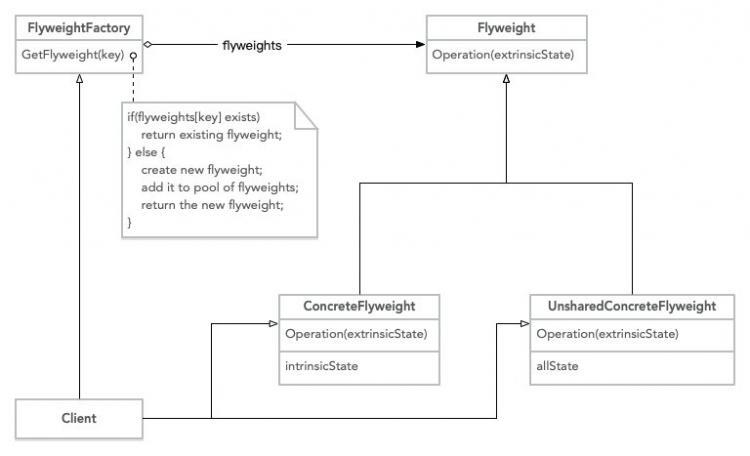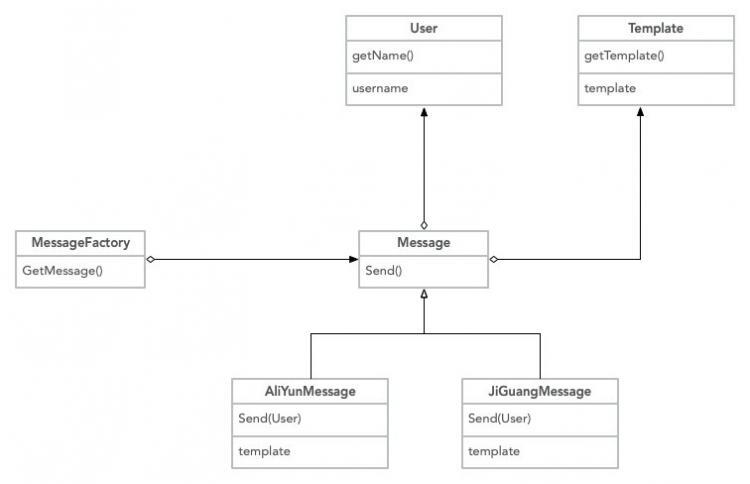【php】PHP设计模式之享元模式
享元模式,“享元”这两个字在中文里其实并没有什么特殊的意思,所以我们要把它拆分来看。“享”就是共享,“元”就是元素,这样一来似乎就很容易理解了,共享某些元素嘛。
Gof类图及解释
GoF定义:运用共享技术有效地支持大量细粒度的对象

interface Flyweight{
public function operation($extrinsicState) : void;
}
class ConcreteFlyweight implements Flyweight
{
private $intrinsicState = 101;
function operation($extrinsicState) : void
{
echo '共享享元对象' . ($extrinsicState + $this->intrinsicState) . PHP_EOL;
}
}
class UnsharedConcreteFlyweight implements Flyweight
{
private $allState = 1000;
public function operation($extrinsicState) : void
{
echo '非共享享元对象:' . ($extrinsicState + $this->allState) . PHP_EOL;
}
}
定义共享接口以及它的实现,注意这里有两个实现,ConcreteFlyweigh进行状态的共享,UnsharedConcreteFlyweight不共享或者说他的状态不需要去共享
class FlyweightFactory{
private $flyweights = [];
public function getFlyweight($key) : Flyweight
{
if (!array_key_exists($key, $this->flyweights)) {
$this->flyweights[$key] = new ConcreteFlyweight();
}
return $this->flyweights[$key];
}
}
保存那些需要共享的对象,做为一个工厂来创建需要的共享对象,保证相同的键值下只会有唯一的对象,节省相同对象创建的开销
$factory = new FlyweightFactory();$extrinsicState = 100;
$flA = $factory->getFlyweight('a');
$flA->operation(--$extrinsicState);
$flB = $factory->getFlyweight('b');
$flB->operation(--$extrinsicState);
$flC = $factory->getFlyweight('c');
$flC->operation(--$extrinsicState);
$flD = new UnsharedConcreteFlyweight();
$flD->operation(--$extrinsicState);
客户端的调用,让外部状态$extrinsicState能够在各个对象之间共享
- 有点意思吧,这个模式的代码量可不算少
- 当一个应用程序使用了大量非常相似的的对象,对象的大多数状都可变为外部状态时,很适合享元模式
- 这里的工厂是存储对象列表的,不是像工厂方法或者抽象工厂一样去创建对象的,虽说这里也进行了创建,但如果对象存在,则会直接返回,而且列表也是一直维护的
- 享元模式在现实中,大家多少一定用过,各种池技术就是它的典型应用:线程池、连接池等等,另外两个一样的字符串String类型在php或Java中都是可以===的,这也运用到了享元模式,它们连内存地址都是一样的,这不就是一种共享嘛
- 关于享元模式,有一个极其经典的例子,比我下面的例子要好的多,那就是关于围棋的棋盘。围棋只有黑白两色,所以两个对象就够了,接下来呢?改变他们的位置状态就好啦!有兴趣的朋友可以搜搜哈!
- Laravel中的IoC容器可以看作是一种享元模式的实现。它把对象保存在数组中,在需要的时候通过闭包机制进行取用,也有一些类有共享一些状态属性的内容。大家可以翻看代码了解了解。
还是说到科技以换壳为本这件事上。毕竟,大家都还是喜欢各种颜色的手机来彰显自己的个性。之前说过,如果每种颜色我们都要做一条生产线的话那岂不是一项巨大的投入。还好,每个型号我们的工厂(享元工厂)只生产最基本的背景壳(对象),然后通过专门的印刷线(状态变化)来进行上色不就好啦!嗯,下一款Iphone早晚也会模仿我们的,看来我们得先把各种金、各种土豪色集齐才行,说不定还能召唤神龙呢!!
完整代码:https://github.com/zhangyue0503/designpatterns-php/blob/master/13.flyweights/source/flyweights.php
实例
果然不出意外的我们还是来发短信,这回的短信依然使用的阿里云和极光短信来进行发送,不过这次我们使用享元模式来实现,这里的享元工厂我们保存了两种不同类型的对象哦,通过内外状态来让它们千变万化吧!

完整源码:https://github.com/zhangyue0503/designpatterns-php/blob/master/13.flyweights/source/flyweights-message.php
<?php
interface Message
{
public function send(User $user);
}
class AliYunMessage implements Message
{
private $template;
public function __construct($template)
{
$this->template = $template;
}
public function send(User $user)
{
echo '使用阿里云短信向' . $user->GetName() . '发送:';
echo $this->template->GetTemplate(), PHP_EOL;
}
}
class JiGuangMessage implements Message
{
private $template;
public function __construct($template)
{
$this->template = $template;
}
public function send(User $user)
{
echo '使用极光短信向' . $user->GetName() . '发送:';
echo $this->template->GetTemplate(), PHP_EOL;
}
}
class MessageFactory
{
private $messages = [];
public function GetMessage(Template $template, $type = 'ali')
{
$key = md5($template->GetTemplate() . $type);
if (!key_exists($key, $this->messages)) {
if ($type == 'ali') {
$this->messages[$key] = new AliYunMessage($template);
} else {
$this->messages[$key] = new JiGuangMessage($template);
}
}
return $this->messages[$key];
}
public function GetMessageCount()
{
echo count($this->messages);
}
}
class User
{
public $name;
public function GetName()
{
return $this->name;
}
}
class Template
{
public $template;
public function GetTemplate()
{
return $this->template;
}
}
// 内部状态
$t1 = new Template();
$t1->template = '模板1,不错哟!';
$t2 = new Template();
$t2->template = '模板2,还好啦!';
// 外部状态
$u1 = new User();
$u1->name = '张三';
$u2 = new User();
$u2->name = '李四';
$u3 = new User();
$u3->name = '王五';
$u4 = new User();
$u4->name = '赵六';
$u5 = new User();
$u5->name = '田七';
// 享元工厂
$factory = new MessageFactory();
// 阿里云发送
$m1 = $factory->GetMessage($t1);
$m1->send($u1);
$m2 = $factory->GetMessage($t1);
$m2->send($u2);
echo $factory->GetMessageCount(), PHP_EOL; // 1
$m3 = $factory->GetMessage($t2);
$m3->send($u2);
$m4 = $factory->GetMessage($t2);
$m4->send($u3);
echo $factory->GetMessageCount(), PHP_EOL; // 2
$m5 = $factory->GetMessage($t1);
$m5->send($u4);
$m6 = $factory->GetMessage($t2);
$m6->send($u5);
echo $factory->GetMessageCount(), PHP_EOL; // 2
// 加入极光
$m1 = $factory->GetMessage($t1, 'jg');
$m1->send($u1);
$m2 = $factory->GetMessage($t1);
$m2->send($u2);
echo $factory->GetMessageCount(), PHP_EOL; // 3
$m3 = $factory->GetMessage($t2);
$m3->send($u2);
$m4 = $factory->GetMessage($t2, 'jg');
$m4->send($u3);
echo $factory->GetMessageCount(), PHP_EOL; // 4
$m5 = $factory->GetMessage($t1, 'jg');
$m5->send($u4);
$m6 = $factory->GetMessage($t2, 'jg');
$m6->send($u5);
echo $factory->GetMessageCount(), PHP_EOL; // 4
- 代码有点多吧,但其实一共是两种类型的类,生成了四种对象。这里每个类不同的对象是根据模板来区分的
- 这样的组合还是比较方便的吧,再结合别的模式将工厂这里优化一下,嗯,前途不可限量,你们可以想想哦!
- 享元模式适用于系统中存在大量的相似对象以及需要缓冲池的场景,能够降低内存占用,提高效率,但会增加复杂度,需要分享内外部状态
- 最主要的特点是有一个唯一标识,当内存中已经有这个对象了,直接返回对象,不用再去创建了
下期看点
享元模式的例子说得有点牵强,不过确实这类设计模式在我们日常的开发中一方面用得不多,另一方面典型的例子又太经典,反正只要记住它的特点就好了,具体在应用的时候说不准写完代码回头一看你会发现这不就是我学过的享元模式嘛!好了,下一篇我们学习一个也是比较少用而且复杂的模式,但是也许你也能经常见到哦!组合模式
各自媒体平台均可搜索【硬核项目经理】
以上是 【php】PHP设计模式之享元模式 的全部内容, 来源链接: utcz.com/a/101350.html



